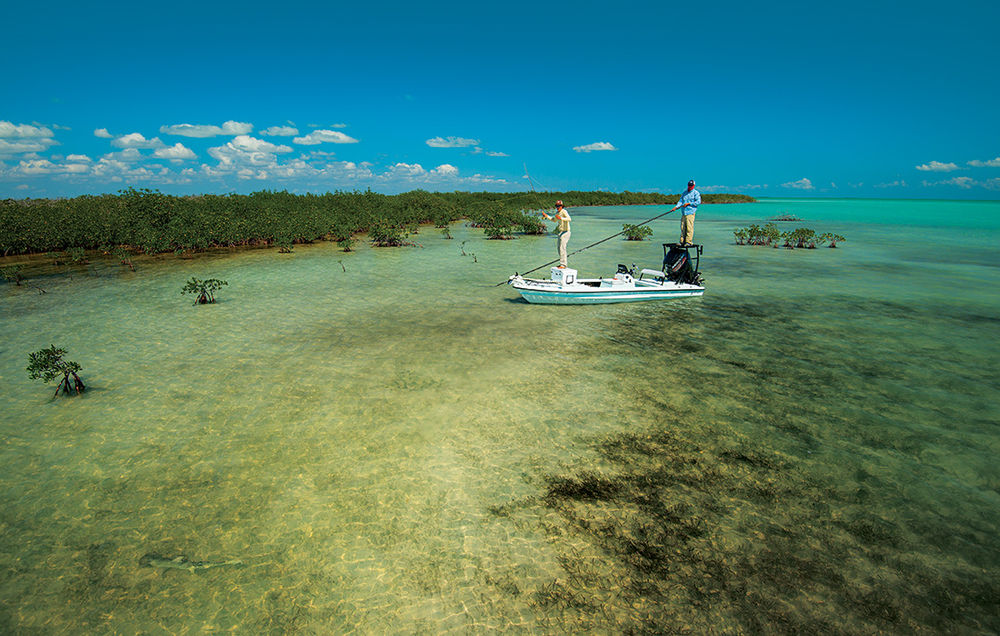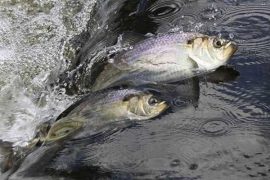
When flats fish head from dark to light bottom, or from deep to shallow water, they often act more vigilant. In this scenario, make your presentation as gentle as possible.
Flats anglers are natural hunters. Much in the same way that deer or hog hunters must identify animal signs, scents and habitat, skinny-water aficionados should understand how to read a flat and react to different variables they encounter. There are many different kinds of shallows, and fishermen are wise to treat them individually. Even the same flat can be fished in numerous ways depending on different conditions. I find it best to treat a flat like a kaleidoscope, with new patterns and elements emerging each trip. All inshore anglers must consider five essential variables when reading a piece of water: wind and air conditions; the sun’s position; water clarity and temperature; the size, shape and composition of the flat; and existing signs of life.
To be thorough, first check the barometric pressure in the area you expect to fish. Barometric pressure — easy to research at fishing-report or weather websites — is particularly relevant to flats anglers because high air pressure can keep water levels low, while low pressure allows water levels to rise. Additionally, a rapidly changing barometer triggers feeding or deters it, depending on the flats species and other variables. Local, on-the-water experiences help anglers understand how barometric pressure affects their favorite flats.
The next factor is air temperature. Air temps are extremely important because, along with direct sunlight, they determine the water temperature on a flat. Water temperature is a strong indicator of which species will be available, depending on their tolerance ranges. Air temps can change rapidly, especially during the approach of a cold front, but water temperatures take longer to react. Therefore one night of chilly weather will not drop a flat’s temperature as significantly as three nights. Conversely, it takes a few days of direct sunlight to get a chilly flat back to conditions that warm-water species prefer.
Another significant factor is wind direction and velocity. Flat, windless days can be great for casting topwater plugs for seatrout, as well as spotting rolling tarpon and tailing bonefish. However, flats fish in these conditions are also far more vigilant and spooky from sudden splashes and movements. Tailing bonefish feeding beneath flat-calm waters require extreme stealth and finesse. Increased winds create wavelets that help mask an angler’s presentation.
Wind direction becomes more relevant as its velocity grows. High winds can affect water level on the flat, keeping it high if the wind opposes a tide or low if the wind augments the tidal direction. The wind direction should therefore determine your poling strategy. If the wind velocity becomes excessive, waters often turn too turbid and dirty for good sight-fishing. This is especially true for flats with soft bottoms of marl or mud. Wind can be a flats fisherman’s friend, but not too much of it!
The second key variable is the amount of available light. Low-light conditions shading a flat favor a topwater bite for species like seatrout, snook and redfish. If I know I’ll have a cloudy day and I’m fishing for bonefish, I’ll fish the shallowest tides and flats so I can spot the bones tailing at the surface. Pick out redfish under the clouds by watching for pushes (surface wakes), tailing commotion or even backs protruding from the water.
When fishing somewhat deeper water where you need to see into the water to spot cruising fish, lots of overhead sunlight is ideal. Brightly lit waters are excellent for the bigger gamesters that need deeper flats, such as cruising permit or tarpon; after all, even a huge permit can’t tail up in 5 feet of water. If you have a patchwork sky, pole toward the blue portions because cloud reflections can make spotting cruising fish difficult. Though many would differ with my strategy, I actually prefer not to wear sunglasses when looking for tailing, rolling, crawling or pushing fish. Conversely, when I need to see into the water column for cruising fish, I don the finest polarized sunglasses I own. My favorite lens colors in shallow waters are vermilion and brown. On cloudy days I use yellow-tinted models.
The third variable is the water itself. Water temperature is paramount; it determines which species will be present and feeding. Naturally, tropical flats fish such as snook, tarpon and permit prefer warmer temperatures. Bonefish can tolerate moderate water temperatures in the 70s, while mid- and south-Atlantic flats feature spotted seatrout, striped bass, redfish and black drum that tolerate colder water. Interestingly, barracuda remain on flats even in cold weather.
Deep water allows fish enough room to swim on the flats proper. I consider moon phases essential components and predictors of depth as well as current velocity. The new and full moons give anglers spring tides, which produce higher highs and lower lows. The quarter moon creates less tidal height change and has more-tepid currents. Always consult tidal charts for each day and the target fishing area, because tides are rarely evenly distributed throughout the day. Some areas have two tides a day, some have four, and some locations, like Charleston, South Carolina, have such large tidal swings that anglers risk stranding their boat if…





